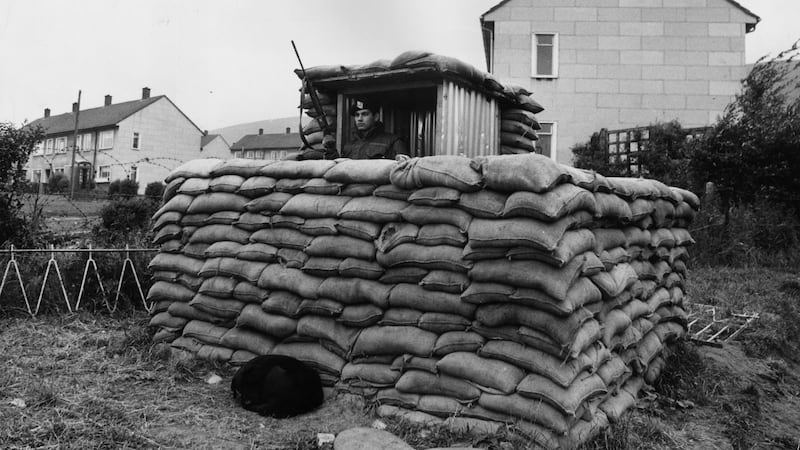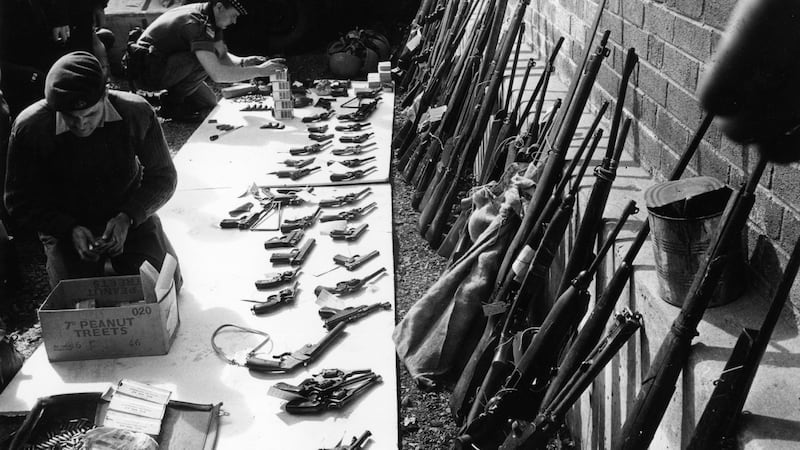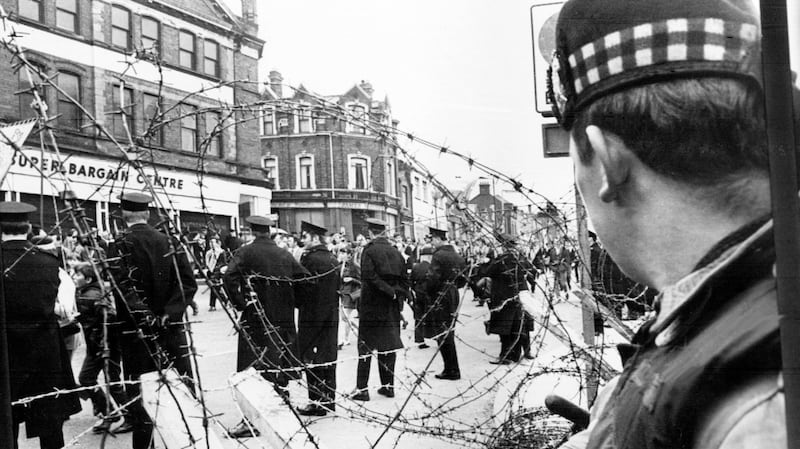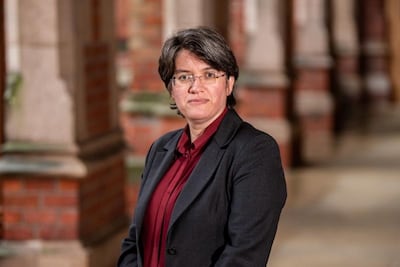“Ulster is not a war zone nor is it likely to become one… an outbreak of Civil War is not an immediate danger.” This was the assessment of the state of Northern Ireland in 1970 by an interfaith delegation from a New York-based foundation involved in global peace campaigning.
The Appeal of Conscience Foundation’s conclusion lends weight to the subsequent scepticism of the senior Stormont civil servant George Quigley as to whether “the Foundation is fully informed on the Northern Ireland situation”.
Details of the delegation’s visit are included in official files predating 1972 that have been released for public viewing from today at the Public Record Office of Northern Ireland (Proni) at Titanic Quarter, Belfast. The documents have been released alongside records from the year 2000 as part of a move towards declassifying Northern Ireland Office files after 20 years.
Visiting Belfast, London and Dublin in July 1970, the delegates – led by Arthur Schneier, rabbi of the Park East Synagogue in New York – met an extensive list of political and religious leaders, senior civil servants, diplomats and journalists, including “an enlightening, if not consoling, meeting with one of the lieutenants of the Rev. Ian Paisley”. This appears to have been William Beattie, then an MP in the Northern Irish House of Commons representing Paisley’s Protestant Unionist Party, the forerunner to the DUP.
The visitors’ gullibility was underlined by their regurgitation of an urban myth about a Belfast Jew being quizzed as to whether he was “Catholic Jewish or Protestant Jewish?” A clearly frustrated civil servant noted in marginalia that it was time that this “apocryphal ... story was crucified dead & buried”.
The eventual outcome of the visit was a fantastically ambitious project aiming to create a utopian new town to be built on a 30,000-acre site “contiguous to troubled areas” in Northern Ireland. Dunmurry was suggested, foreshadowing the subsequent DeLorean experiment. The town would be religiously mixed in which “[a]ll churches must share halls, committee rooms and other facilities”.
[ Civil servants advised to assume UK ministers’ relative ignorance on North, new files show ]
It would be centred around a factory (manufacturing an unspecified product) and the factory workers would live in “integrated estates in a ring around the town centre and schools”, which would also be integrated for the children of the factory workers. The issue of accessing the town would be solved by the simple expedient of public transport that would be as “effective and cheap as possible”.
This plan, suggested in the summer of 1972 soon after the introduction of direct rule, was the brainchild of Joseph P Williams, a wealthy banker who had introduced the first nationwide credit card – the BankAmericard, which later evolved into the Visa brand – to the US in 1958. While civil servants in the newly established Northern Ireland Office were understandably dubious about the project’s feasibility, they were unwilling to dismiss outright a potentially lucrative approach from an influential and affluent international benefactor.
[ July 3rd, 1970: the day they unleashed the ParasOpens in new window ]
A serious flaw in the scheme was the nature of the manufacturing industry around which the town would be centred. Concerns about the lack of skilled labour led Mr Williams to suggest cardboard boxes. The main difficulty, as identified by civil servants, was the structure of the North’s economy and the need to find suitable “products and assured markets”.
A further challenge would arise in finding people willing not just to work across the community divide, but also to live side by side. Previous efforts at “community housing” had foundered on the pervading sectarian division within housing and this scheme’s remote chance of success would rest on selecting people “sufficiently immune from community pressures and influences not to be sucked into the vortex of recurring community strife”.

Mr Williams identified another wealthy Irish-American businessman, Jack Mulcahy, to run his town’s administrative corporation. Mr Mulcahy, who was born in Dungarvan, was a millionaire chemical industry executive who had just brought Pfizer to Ringaskiddy. In spite of his wealth and influence (in 1972 he was also a significant contributor to US president Richard Nixon’s re-election campaign), civil servants admitted not to knowing who he was.
As such they were understandably concerned to discover that he was “an IRA activist in the old glory days”, if at pains to emphasise that he was “in no way involved” with republicanism since emigrating to the US after his release from prison in 1923 following the cessation of the Irish Civil War.

Fruitless discussions continued throughout 1973 with civil servants growing increasingly wary of the foundation’s ignorance of the reality of life in Northern Ireland during some of the worst years of the Troubles. By October 1973 it was decided that “any future contacts with this Foundation should be played on a fairly low key” and the prospect of the restoration of powersharing following the Sunningdale talks was a convenient means of shelving the plan.
Ambitious infrastructure projects feature elsewhere in this current release of historic files predating 1972. The recurring topic of constructing a physical transportation link between Northern Ireland and Scotland was discussed at length during the 1960s.
A significant hike in cross-channel freight costs in 1960 prompted a Moira butcher, George McCartney, to convince his local district council to lobby for “the construction of a Tunnel between Donaghadee and Portpatrick as an alternative means of access to the mainland”. The suggestion received little support from the Ministry of Development, which concluded that “the tunnel is not an economic proposition”.
The ministry could not ignore so easily two serious propositions for an “Ulster Channel Tunnel” proposed by engineers in 1964, prompted by the Anglo-French agreement that year to build the English channel tunnel. Frank Davidson, president of the American-based Technical Studies Inc., who was involved in the channel tunnel study group, approached the Northern Ireland government to explore the feasibility of the northern equivalent.

As Mr Davidson’s company was “backed by a number of extremely reputable American financial and other organisations” (including Morgan Guaranty and John Hancock Mutual Life Insurance), Ken Bloomfield of the Cabinet Office in Stormont thought that “it might not be a complete waste of time to see what Mr Davidson has to say”. There was never any indication that officials thought a tunnel to be likely but they were interested to see whether Mr Davidson had ideas on how to improve transport links between the two islands more generally.
In the same year, Alan Arthur Wells, an engineer based in the British Welding Research Association near Cambridge, submitted a dense 12-page proposal including maps and technical plans for an undersea railway tube linking Float Bay in Galloway to Donaghadee, with railway extensions on land on either side to Dunraigt and Carnalea.
In an effort to circumvent the biggest challenges to the building of an undersea tunnel in that region – the depth of the seabed and the hazards posed by the dumping of wartime munitions in Beaufort’s Dyke – Mr Wells’s proposal envisaged constructing tubes on land at both ends and pushing them out to sea to meet in the middle. Soon after making the proposal, Mr Wells became Professor of Structural Science at Queen’s University Belfast and was keen to obtain government funding for his university department to explore further his proposal’s feasibility.

The eventual rejection of his plan was based not on its engineering merit but on its economic shortcomings. His estimate of £35 million and his predictions for the volume of traffic that would use the tunnel were considered to be “rather crude and grossly over-optimistic”.
Another civil servant raised concerns about the public’s willingness to use such a tunnel: “I believe that not enough thought has been given to the human side of the proposition. Homo Sapiens does not like tunnels – even short ones”. His view that “a tunnel is not even a starter” was largely echoed by the Sir Peter Hendy’s 2021 Union Connectivity report, which did not give any serious consideration to Boris Johnson’s most recent revival of the ‘Ulster Channel Tunnel’ idea.
Professor Marie Coleman is professor of 20th-Century Irish history at Queen’s University Belfast











